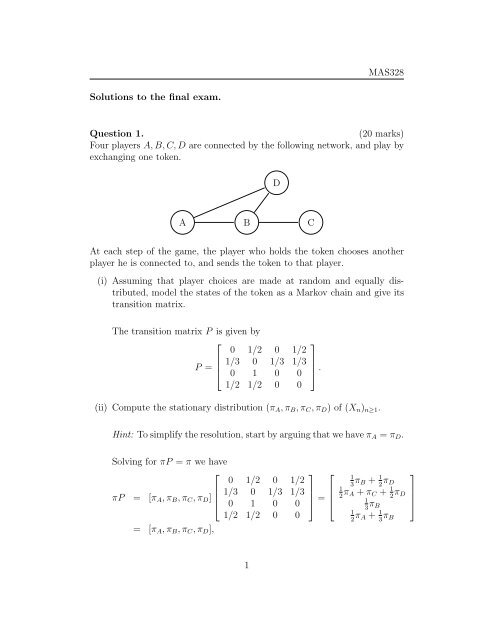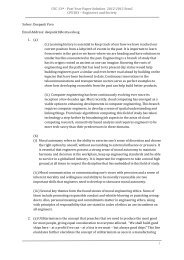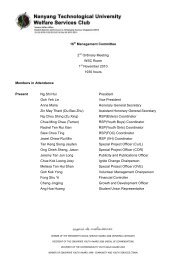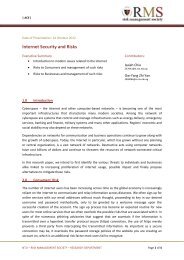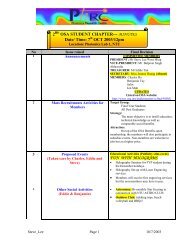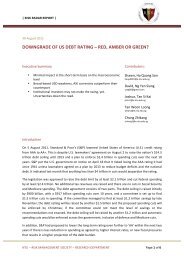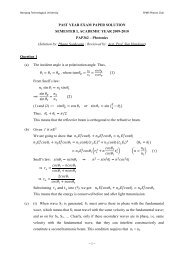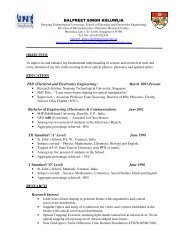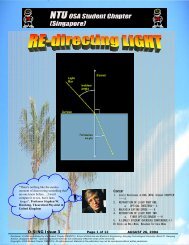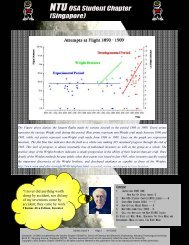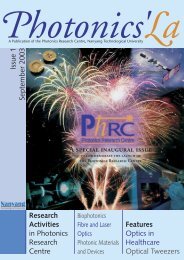MAS328 Solutions to the final exam. Question 1. (20 marks) Four ...
MAS328 Solutions to the final exam. Question 1. (20 marks) Four ...
MAS328 Solutions to the final exam. Question 1. (20 marks) Four ...
Create successful ePaper yourself
Turn your PDF publications into a flip-book with our unique Google optimized e-Paper software.
<strong>Solutions</strong> <strong>to</strong> <strong>the</strong> <strong>final</strong> <strong>exam</strong>.<br />
<strong>MAS328</strong><br />
<strong>Question</strong> <strong>1.</strong> (<strong>20</strong> <strong>marks</strong>)<br />
<strong>Four</strong> players A, B, C, D are connected by <strong>the</strong> following network, and play by<br />
exchanging one <strong>to</strong>ken.<br />
D<br />
A B C<br />
At each step of <strong>the</strong> game, <strong>the</strong> player who holds <strong>the</strong> <strong>to</strong>ken chooses ano<strong>the</strong>r<br />
player he is connected <strong>to</strong>, and sends <strong>the</strong> <strong>to</strong>ken <strong>to</strong> that player.<br />
(i) Assuming that player choices are made at random and equally distributed,<br />
model <strong>the</strong> states of <strong>the</strong> <strong>to</strong>ken as a Markov chain and give its<br />
transition matrix.<br />
The transition matrix P is given by<br />
⎡<br />
0<br />
⎢<br />
P = ⎢ 1/3<br />
⎣ 0<br />
1/2<br />
0<br />
1<br />
0<br />
1/3<br />
0<br />
⎤<br />
1/2<br />
1/3 ⎥<br />
0 ⎦<br />
1/2 1/2 0 0<br />
.<br />
(ii) Compute <strong>the</strong> stationary distribution (πA, πB, πC, πD) of (Xn)n≥<strong>1.</strong><br />
Hint: To simplify <strong>the</strong> resolution, start by arguing that we have πA = πD.<br />
Solving for πP = π we have<br />
πP =<br />
⎡<br />
0<br />
⎢<br />
[πA, πB, πC, πD] ⎢ 1/3<br />
⎣ 0<br />
1/2<br />
0<br />
1<br />
0<br />
1/3<br />
0<br />
⎤<br />
1/2<br />
1/3 ⎥<br />
0 ⎦<br />
1/2 1/2 0 0<br />
=<br />
⎡<br />
⎢<br />
⎣<br />
= [πA, πB, πC, πD],<br />
1<br />
1<br />
3πB + 1<br />
2πD 1<br />
2πA + πC + 1<br />
2πD 1<br />
3πB 1<br />
2πA + 1<br />
3πB ⎤<br />
⎥<br />
⎦
<strong>MAS328</strong><br />
i.e. πA = πD = 2πC and πB = 3πC, which, under <strong>the</strong> condition πA +<br />
πB + πC + πD = 1, gives πA = 1/4, πB = 3/8, πC = 1/8, πD = 1/4.<br />
(iii) In <strong>the</strong> long run, what is <strong>the</strong> probability that player D holds <strong>the</strong> <strong>to</strong>ken ?<br />
This probability is πD = 0.25.<br />
(iv) On average, how long does player D has <strong>to</strong> wait <strong>to</strong> recover <strong>the</strong> <strong>to</strong>ken ?<br />
This average time is 1/πD = 4.<br />
<strong>Question</strong> 2. (<strong>20</strong> <strong>marks</strong>)<br />
A system consists of two machines and two repairmen. The amount of time<br />
that an operating machine works before breaking down is exponentially distributed<br />
with mean 5. The amount it takes a single repairman <strong>to</strong> fix a<br />
machine is exponentially distributed with mean 4. Only one repairman can<br />
work on a failed machine at any given time.<br />
(i) Let Xt be <strong>the</strong> number of machines in operating condition at time t ∈<br />
R+. Show that Xt is a continuous time Markov process and complete<br />
<strong>the</strong> missing entries in <strong>the</strong> matrix<br />
of its genera<strong>to</strong>r.<br />
⎡<br />
Q = ⎣<br />
0.5 0<br />
0.2 <br />
0 −0.4<br />
The genera<strong>to</strong>r Q of Xt is given by<br />
⎡<br />
−0.5 0.5 0<br />
⎤<br />
Q = ⎣ 0.2 −0.45 0.25 ⎦ .<br />
0 0.4 −0.4<br />
2<br />
⎤<br />
⎦
(ii) Calculate <strong>the</strong> long run probability distribution (π0, π1, π2) for Xt.<br />
Solving for πQ = 0 we have<br />
⎡<br />
πQ = [π0, π1, π2] ⎣<br />
⎡<br />
−0.5 0.5 0<br />
0.2 −0.45 0.25<br />
0 0.4 −0.4<br />
= ⎣<br />
−0.5 × π0 + 0.2 × π1<br />
0.5 × π0 − 0.45 × π1 + 0.4 × π2<br />
0.25 × π1 − 0.4 × π2<br />
= [0, 0, 0],<br />
⎤<br />
⎦<br />
⎤<br />
⎦<br />
T<br />
<strong>MAS328</strong><br />
i.e. π0 = 0.4 × π1 = 0.64 × π2 under <strong>the</strong> condition π0 + π1 + π2 = 1,<br />
which gives π0 = 16/81, π1 = 40/81, π2 = 25/8<strong>1.</strong><br />
(iii) Compute <strong>the</strong> average number of operating machines in <strong>the</strong> long run.<br />
In <strong>the</strong> long run <strong>the</strong> average is<br />
0 × π0 + 1 × π1 + 2 × π2 = 40/81 + 50/81 = 90/8<strong>1.</strong><br />
(iv) If an operating machine produces 100 units of output per hour, what<br />
is <strong>the</strong> long run output per hour of <strong>the</strong> system ?<br />
We find<br />
100 × 90/81 = 1000/9.<br />
<strong>Question</strong> 3. (<strong>20</strong> <strong>marks</strong>)<br />
Families in a distant society continue <strong>to</strong> have children until <strong>the</strong> first girl, and<br />
<strong>the</strong>n cease childbearing. Let X denote <strong>the</strong> number of male offsprings of a<br />
particular husband.<br />
(i) Assuming that each child is equally likely <strong>to</strong> be a boy or a girl, give <strong>the</strong><br />
probability distribution of X.<br />
We have P(X = k) = (1/2) k+1 , k ∈ N.<br />
3
(ii) Compute <strong>the</strong> probability generating function G(s) of X.<br />
The probability generating function of X is given by<br />
G(s) = E[s X ] = 1<br />
2<br />
∞<br />
k=0<br />
(s/2) k = 1<br />
2 − s .<br />
<strong>MAS328</strong><br />
(iii) What is <strong>the</strong> probability that <strong>the</strong> husband’s male line of descent will<br />
cease <strong>to</strong> exist by <strong>the</strong> third generation ?<br />
The probability we are looking for is<br />
G(G(G(0))) =<br />
1<br />
2 − 1<br />
2−1/2<br />
= 3<br />
4 .<br />
<strong>Question</strong> 4. (<strong>20</strong> <strong>marks</strong>)<br />
Suppose that X(A) is a spatial Poisson process of discrete items scattered<br />
on <strong>the</strong> plane R 2 with intensity λ = 0.5 per square meter. No evaluation of<br />
numerical expressions is required in this question.<br />
(i) What is <strong>the</strong> probability that 10 items are found within <strong>the</strong> disk D(0, 3)<br />
with radius 3 meters centered at <strong>the</strong> origin ?<br />
This probability is<br />
−9π/2 (9π/2)10<br />
e .<br />
10!<br />
(ii) What is <strong>the</strong> probability that 5 items are found within <strong>the</strong> disk D(0, 3)<br />
and 3 items are found within <strong>the</strong> disk D(x, 3) with x = (7, 0) ?<br />
This probability is<br />
−9π/2 (9π/2)5<br />
e<br />
5!<br />
4<br />
(9π/2)3<br />
× e−9π/2 .<br />
3!
<strong>MAS328</strong><br />
(iii) What is <strong>the</strong> probability that 8 items are found anywhere within D(0, 3)∪<br />
D(x, 3) with x = (7, 0) ?<br />
This probability is<br />
−9π (9π)8<br />
e .<br />
8!<br />
<strong>Question</strong> 5. (<strong>20</strong> <strong>marks</strong>)<br />
Let (ξn)n≥0 be a two-state Markov chain on {0, 1} with transition matrix<br />
<br />
0<br />
1 − α<br />
<br />
1<br />
,<br />
α<br />
let (Nt)t∈R+ be a Poisson process with parameter λ > 0, and let <strong>the</strong> two-state<br />
birth and death process Xt be defined by<br />
Xt = ξNt, t ∈ R+.<br />
(i) Compute <strong>the</strong> mean return time E[τ0 | X0 = 0] <strong>to</strong> 0 of Xt.<br />
We have<br />
and<br />
hence<br />
and<br />
E[τ0 | X0 = 0] = 1<br />
λ + E[τ0 | X0 = 1],<br />
E[τ0 | X0 = 1] = 1<br />
λ + αE[τ0 | X0 = 1],<br />
E[τ0 | X0 = 1] =<br />
E[τ0 | X0 = 0] =<br />
5<br />
1<br />
λ(1 − α)<br />
2 − α<br />
λ(1 − α) .
(ii) Compute <strong>the</strong> mean return time E[τ1 | X0 = 1] <strong>to</strong> 1 of Xt.<br />
We have<br />
<strong>MAS328</strong><br />
E[τ1 | X0 = 1] = 1<br />
λ + αE[τ1 | X0 = 1] + (1 − α)E[τ1 | X0 = 0]<br />
= 2 − α<br />
λ + αE[τ1 | X0 = 1],<br />
since E[τ1 | X0 = 0] = 1/λ, hence<br />
E[τ1 | X0 = 1] =<br />
2 − α<br />
λ(1 − α) .<br />
(iii) Determine <strong>the</strong> genera<strong>to</strong>r of <strong>the</strong> process Xt in terms of α and λ.<br />
The genera<strong>to</strong>r Q of Xt is given by<br />
<br />
−λ λ<br />
Q =<br />
λ(1 − α) −λ(1 − α)<br />
6<br />
<br />
.


